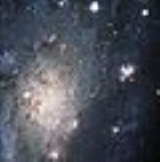
NGC 2403
Encyclopedia
NGC 2403 is an intermediate spiral galaxy
in the constellation Camelopardalis
. NGC 2403 is an outlying member of the M81 Group
, and is approximately 8 million light-year
s distant. It bears a striking similarity to M33
, being about 50,000 light years in diameter and containing numerous star-forming H II region
s.
The northern spiral arm connects it to nearby galaxy NGC 2404. NGC 2403 can be observed using 10×50 binoculars
.
e in the galaxy: SN 1954J, which attained a magnitude of 16 at its brightest, and SN 2004dj
.
in 1788. Allan Sandage
detected Cepheid variable
s in NGC 2403 using the Hale telescope
, giving it the distinction of being the first galaxy beyond our local group
within which a Cepheid was discovered. He derived a distance of a mere 8 thousand light years. Today, it is thought to be a thousand times further away at about 8 million light years (3.6 Mpc).
Intermediate spiral galaxy
An intermediate spiral galaxy is a galaxy that is in between the classifications of a barred spiral galaxy and an unbarred spiral galaxy. It is designated as SAB in the galaxy morphological classification scheme.-Grades:...
in the constellation Camelopardalis
Camelopardalis
Camelopardalis is a large but faint constellation in the northern sky. The constellation was introduced in 1612 by Petrus Plancius. Some older astronomy books give an alternative spelling of the name, Camelopardus.-Etymology:...
. NGC 2403 is an outlying member of the M81 Group
M81 Group
The M81 Group is a group of galaxies in the constellation Ursa Major that includes the well-known galaxies Messier 81 and Messier 82, as well as several other galaxies with high apparent brightnesses. The approximate center of the group is located at a distance of 3.6 Mpc, making it one of the...
, and is approximately 8 million light-year
Light-year
A light-year, also light year or lightyear is a unit of length, equal to just under 10 trillion kilometres...
s distant. It bears a striking similarity to M33
M33
M33, M-33, or M.33 may refer to:* M-33 , a state highway in Michigan* M33 cluster bomb, a Cold War-era U.S. biological cluster bomb* HMS M33, an M29-class monitor warship of the Royal Navy...
, being about 50,000 light years in diameter and containing numerous star-forming H II region
H II region
An H II region is a large, low-density cloud of partially ionized gas in which star formation has recently taken place. The short-lived, blue stars forged in these regions emit copious amounts of ultraviolet light, ionizing the surrounding gas...
s.
The northern spiral arm connects it to nearby galaxy NGC 2404. NGC 2403 can be observed using 10×50 binoculars
Binoculars
Binoculars, field glasses or binocular telescopes are a pair of identical or mirror-symmetrical telescopes mounted side-by-side and aligned to point accurately in the same direction, allowing the viewer to use both eyes when viewing distant objects...
.
Supernovae
As of late 2004, there had been two reported supernovaSupernova
A supernova is a stellar explosion that is more energetic than a nova. It is pronounced with the plural supernovae or supernovas. Supernovae are extremely luminous and cause a burst of radiation that often briefly outshines an entire galaxy, before fading from view over several weeks or months...
e in the galaxy: SN 1954J, which attained a magnitude of 16 at its brightest, and SN 2004dj
SN 2004dj
SN 2004dj was the brightest supernova since SN 1987A at the time of its discovery.This Type II-P supernova was discovered by Koichi Itagaki, a Japanese astronomer on July 31, 2004. At the time of its discovery, its apparent brightness was 11.2 visual magnitude; the discovery occurred after the...
.
History
NGC 2403 was discovered by William HerschelWilliam Herschel
Sir Frederick William Herschel, KH, FRS, German: Friedrich Wilhelm Herschel was a German-born British astronomer, technical expert, and composer. Born in Hanover, Wilhelm first followed his father into the Military Band of Hanover, but emigrated to Britain at age 19...
in 1788. Allan Sandage
Allan Sandage
Allan Rex Sandage was an American astronomer. He was Staff Member Emeritus with the Carnegie Observatories in Pasadena, California. He is best known for determining the first reasonably accurate value for the Hubble constant and the age of the universe.-Career:Sandage was one of the most...
detected Cepheid variable
Cepheid variable
A Cepheid is a member of a class of very luminous variable stars. The strong direct relationship between a Cepheid variable's luminosity and pulsation period, secures for Cepheids their status as important standard candles for establishing the Galactic and extragalactic distance scales.Cepheid...
s in NGC 2403 using the Hale telescope
Hale telescope
The Hale Telescope is a , 3.3 reflecting telescope at the Palomar Observatory in California, named after astronomer George Ellery Hale. With funding from the Rockefeller Foundation, he orchestrated the planning, design, and construction of the observatory, but did not live to see its commissioning...
, giving it the distinction of being the first galaxy beyond our local group
Local Group
The Local Group is the group of galaxies that includes Earth's galaxy, the Milky Way. The group comprises more than 30 galaxies , with its gravitational center located somewhere between the Milky Way and the Andromeda Galaxy...
within which a Cepheid was discovered. He derived a distance of a mere 8 thousand light years. Today, it is thought to be a thousand times further away at about 8 million light years (3.6 Mpc).
External links
- Spiral Galaxy NGC 2403 at the astro-photography site of Mr. Takayuki Yoshida
- NGC 2403 at ESA/Hubble

